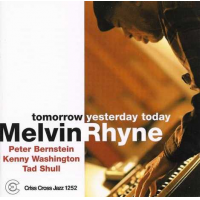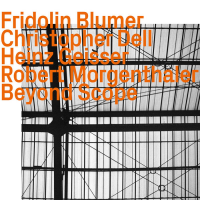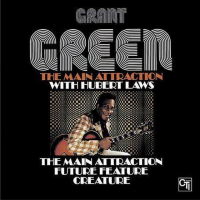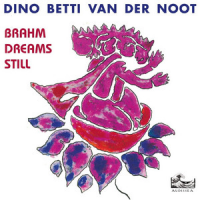Home » Jazz Articles » Liner Notes » Dino Betti van der Noot: Let Us Recount Our Dreams
Dino Betti van der Noot: Let Us Recount Our Dreams
Still, I was curious. Enzo is the Artistic Consultant to the Umbria Jazz Festival, and is famously guarded with his praise. He rarely employs a superlative like "best in Italy." Soon after the call from Enzo, Dino emailed me, introduced himself, and said he wanted to send me an advance copy of his new record. I told him I was too busy to write the liner notes. He sent it anyway, by express mail from Milan. Eventually I played it. Within five minutes, I knew I had to write the liner notes.
Let Us Recount Our Dreams is a kind of big band jazz I had never heard before. It is complex. (Dino's arrangements for his 23-piece ensemble contain many moving parts.) It is continuously evolving. (You have to be alert for the transitions.) It is volatile. (It hits hard enough to knock you down.) Its dynamic range is huge. (It knocks you down, then whispers in your ear.) Its sonorities are atypical. (How many jazz bands contain a harp and a dizi, a Chinese bamboo flute?)
Dino's music made me think of Gil Evans. Like Evans, Dino was a colorist with a special gift for voicings. Like Evans, he was a born storyteller who dealt in dramatic, sweeping musical narratives. Their works had in common an affirmational loftiness, a grandeur. Yet there were significant aesthetic differences. Evans was an impressionist. His touch was subtle. Dino was a bold expressionist who sometimes engaged in stunning interludes of impressionism, such as "Love Song for a Blue Gal." (More about that gorgeous almost-ballad later.)
The history of jazz is full of strange tales and colorful characters. But in my research for these notes, I encountered one of the most extraordinary and improbable jazz biographies ever. Dino's father was an officer in the Italian military who died in Africa in 1936, five months before Dino was born. His mother was a classical pianist. When he was very small, Dino used to sit beneath the piano when his mother practiced Debussy preludes. He took violin lessons when he was young but says he was "terrible" and gave it up after four or five years. Yet playing in a student orchestra provided a pivotal experience. He says, "I discovered how wonderful it was to play an instrument within an orchestra, to feel the sensation of my sound becoming part of a much larger sound." When Dino heard the Stan Kenton band in Milan in 1956, a life-long fascination for large ensembles was instilled.
But music has never been his day job. He matriculated at Bocconi Universitá in Milan and studied economics. After college he worked as an accountant and statistician. His girlfriend was studying architecture but she made animation films for advertising on the side. Dino began to write stories and music for these films. He quit his job and his girlfriend dropped out of architecture school and together they started a small advertising studio in Milan. He says, "We learned everything by ourselves." They built their studio into one of Italy's major advertising agencies. Eventually they had 50 employees and clients lilke IBM, Duracell, Citroën and Aramis. The first songs Dino wrote were advertising jingles.
In 1967 he became ill with hepatitis and stayed home from work for three months. For something to do, he took up the tenor saxophone and flute. He had a friend who was an amateur musician. Dino talked his friend into helping him organize an amateur big band. For several years, a group of musicians met in Dino's basement every Monday night. At first, they practiced simple arrangements that Dino purchased from the United States. Eventually Dino tried to write his own arrangements. He began to take a correspondence course from the Berklee College of Music. From the 1950s into the 1970s, long before the internet, Berklee offered instruction by mail on subjects like theory, harmony and arranging to aspiring musicians who were not able to get to the physical campus in Boston.
Dino says, "I learned how to arrange and orchestrate. I stopped playing saxophone and flute in the band, which improved it." In 1977 Dino released an album, Basement Big Band, with his arrangements of tunes associated with some of his idols, like Ellington, Basie and Kenton. But he had already begun composing his own originals, and he soon realized that his amateur band could not play them. It was six more years before he released his first recording with an orchestra of professional musicians. A Midwinter Night's Dream came out in 1983. Now, 40 years later, with Let Us Recount Our Dreams, he has released his 16th album. Both titles reference two of his recurrent fixations: Shakespeare and dreams.
He is an enormously accomplished composer/arranger with a large and distinguished body of work who has never been a full-time working musician. In the jazz world at large, Dino is a well-kept secret. But in my research, I did discover some important acknowledgements of his achievement over the years. Respected American critics like Nat Hentoff, Ira Gitler, Neil Tesser and Kevin Whitehead had reviewed his records with high praise. They had also written liner notes for his early albums. As far back as 1987, in a review of Dino's fourth album, They Cannot Know, Tesser had written (in USA Today), "This Italian composer/arranger may well be writing the world's most inventive music for jazz orchestra." Important Italian publications like Musica Jazz and Musica e dischi knew about Dino—or at least they did once. In the former, several of Dino's records had been "Album of the Year." In the latter, They Cannot Know was designated the best Italian jazz album of the 1980's.
But these examples come mostly from many years ago. As attempts to counteract Dino's obscurity, they failed. His reputation today, to the extent that he has one, is largely limited to Italy. One reason is that his bands don't tour. In fact, they rarely perform in public. Another reason is that, with the exception of three titles on Soul Note many years ago, he has never had the support of a major record label. Another reason is that, between 1989 and 2005, he released no new records. He says, "It seemed to me then that I had nothing else to say." (He was wrong. His roughly biannual album production resumed in 2005, with Ithaca/Ithaki.)
The first piece on Let Us Recount Our Dreams, the title track, immediately submerges us in the world of Dino. It has all of his signature elements: The premonitory opening, as themes gradually gather and loom. The treble details sifting through the ensemble from harp and cymbals and other mysterious percussion devices. The rich colors of the instrumental blends. The stunning soloists, unleashed.
From his earliest albums, Dino's use of soloists has been distinctive. He says, "The solos should not be exhibitions, but functional to the composition structure." Dino's individual improvisers always sound deeply integrated into the total ensemble design, even when they are wildly creative. For a listener new to Dino, one of the revelations of this album will be the quality of the soloists, none of them famous. On the title track, Alberto Mandarini on flugelhorn and Giulio Visibelli on tenor saxophone offer profound personal interpretations of Dino's intimation that life is a dream. (The band's personnel has been remarkably stable over the years. Three players have been in the orchestra since the 1980s. Fifteen have been there 10 years or longer.)
Another distinctive element is Dino's approach to rhythm. You don't see many jazz bands with six-piece rhythm sections (two keyboardists/three percussionists/one electric bassist). But there is an irony here. Dino is obsessed with rhythm in order to set it free. The three drummers, Stefano Bertoli, Tiziano Tononi and Federico Sanesi, are all intriguing in different ways. None of them "keep time." They create concurrent fields of energy within which, or against which, melodies move. Electric bassist Gianluca Alberti is the power center of Dino's ensemble. Only a badass bassist is capable of conducting an ongoing dialog with an entire orchestra.
"Children of the Zodiac" is one of Dino's many compositions with sources in English literature. Rudyard Kipling believed that art makes possible a higher state of consciousness. All of Dino's music seeks transcendence. "Children of the Zodiac" is also classic Dino in its confluences, even its collisions, of multiple themes. (Transcendence is rarely achieved without conflict.) The star of the piece (in this band theoretically without stars) is Emanuele Parrini. There has been a violin renaissance in jazz in recent years. In Parrini's hands, the violin speaks directly to and from the human heart. Other vivid moments on this track come from vibraphonist Luca Gusella and pianist Niccolò Cattaneo.
"Love Song for a Blue Gal" is for Dino's wife Titti. Dino married that aforementioned girlfriend with whom he started an advertising agency. She became an important creative director in the world of advertising and a well-known designer, with pieces in major museums.They have been together since 1954. The tenderness of the melody is deeply affecting. Irish harpist Vincenzo Zitello and multi-instrumentalist Sandro Cerino (here on bass clarinet) are two more stars of this band without stars. On this track they are both indispensable to the realization of Dino's immersion in memory. The piano solo by Cattaneo introduces some twists and hard turns into this otherwise rapt ballad. (All love stories are complicated, especially those of 69 years.) Before the end, the song returns to where it started, in a melody like a long-held embrace.
The sea is another preoccupation that haunts Dino's imagination. "High Seas" hurtles through the waves, riding on a mighty ensemble vamp. Visibelli is powerful on this piece. Cerino's soprano saxophone solo, dedicated to the late Wayne Shorter, turns the song momentarily peaceful. (On the day I first listened to "High Seas," I got an email from Dino with a photo of the sun sinking into the Tyrrhenian Sea. At that very moment, he was on his boat, sailing between Corsica and Elba Island. He has been a sailor his whole life, and has won regattas.)
"The Night's Black Mantle" is another phrase from Shakespeare. It has the sense of gradually developing meanings, of hidden messages coming to the surface, that is so representative of Dino's work. What is also typical is how the form alters and shifts. There are suspenseful lulls that resolve in outbreaks of emotion. The contrasts within this piece are epitomized by the two very different trombone solos by Luca Begoniia and Stefano Calcagno. They are two more of Dino's inspired interpreters.
My friend Enzo was right, but he didn't go far enough. Dino Betti van der Noot, that unschooled musician, that part-time bandleader, that sailor of the seas of life, is not just the best jazz composer in Italy. He is one of the best jazz composers anywhere.
Liner Notes copyright © 2026 Thomas Conrad.
Let Us Recount Our Dreams can be purchased here.
Contact Thomas Conrad at All About Jazz.
Thomas travels frequently writing about jazz outside the borders of the United States.
Track Listing
Let Us Recount Our Dreams; Children of the Zodiac; Love Song for a Blue Gal; High Seas; The Night's Black Mantle.
Personnel
Dino Betti van der Noot
composer / conductorGianpiero LoBello
trumpetAlberto Mandarini
trumpetMario Mariotti
trumpetPaolo De Ceglie
trumpetLuca Begonia
tromboneStefano Calcagno
tromboneEnrico Allavena
tromboneGianfranco Marchesi
tromboneSandro Cerino
saxophone, altoAndrea Ciceri
saxophone, altoGiulio Visibelli
saxophone, tenorRudi Manzoli
saxophone, tenorGilberto Tarocco
saxophone, baritoneLuca Gusella
vibraphoneEmanuele Parrini
violinNiccolò Cattaneo
pianoFilippo Rinaldo
keyboardsVincenzo Zitello
harpGianluca Alberti
bass, electricAdditional Instrumentation
Gianpiero LoBello, Alberto Mandarini, Mario Mariotti, Paolo De Ceglie: flugelhorn; Gianfranco Marchesi: bass trombone; Sandro Cerino: flute, dizi, bass clarinet, soprano saxophone; Giulio Visibelli: flute; Gilberto Tarocco, clarinet; Stefano Bertoli, drums; Tiziano Tononi, percussions; Federico Sanesi, tabla.
Album information
Title: Let Us Recount Our Dreams | Year Released: 2023 | Record Label: Audissea
Tags
About Dino Betti van der Noot
Instrument: Composer / conductor
PREVIOUS / NEXT
Support All About Jazz
 All About Jazz has been a pillar of jazz since 1995, championing it as an art form and, more importantly, supporting the musicians who make it. Our enduring commitment has made "AAJ" one of the most culturally important websites of its kind, read by hundreds of thousands of fans, musicians and industry figures every month.
All About Jazz has been a pillar of jazz since 1995, championing it as an art form and, more importantly, supporting the musicians who make it. Our enduring commitment has made "AAJ" one of the most culturally important websites of its kind, read by hundreds of thousands of fans, musicians and industry figures every month.
























